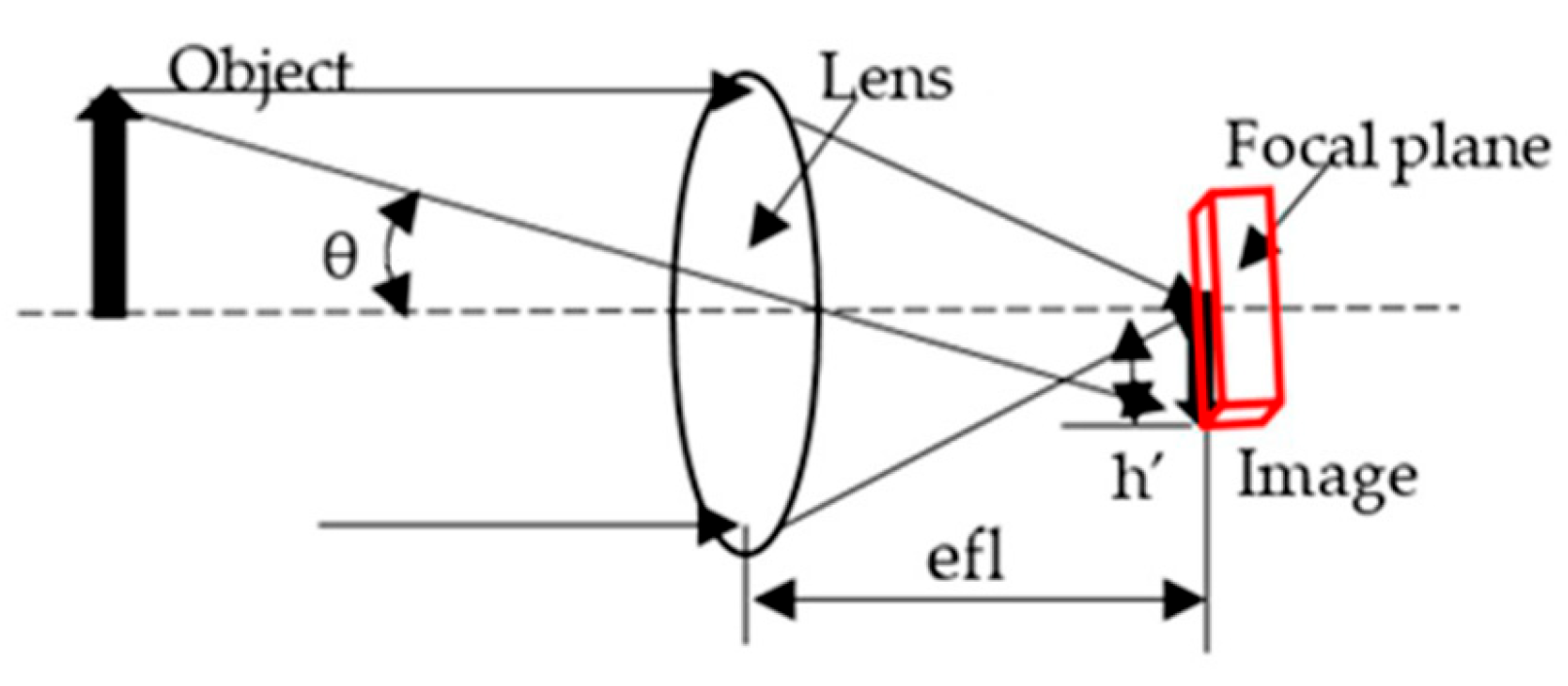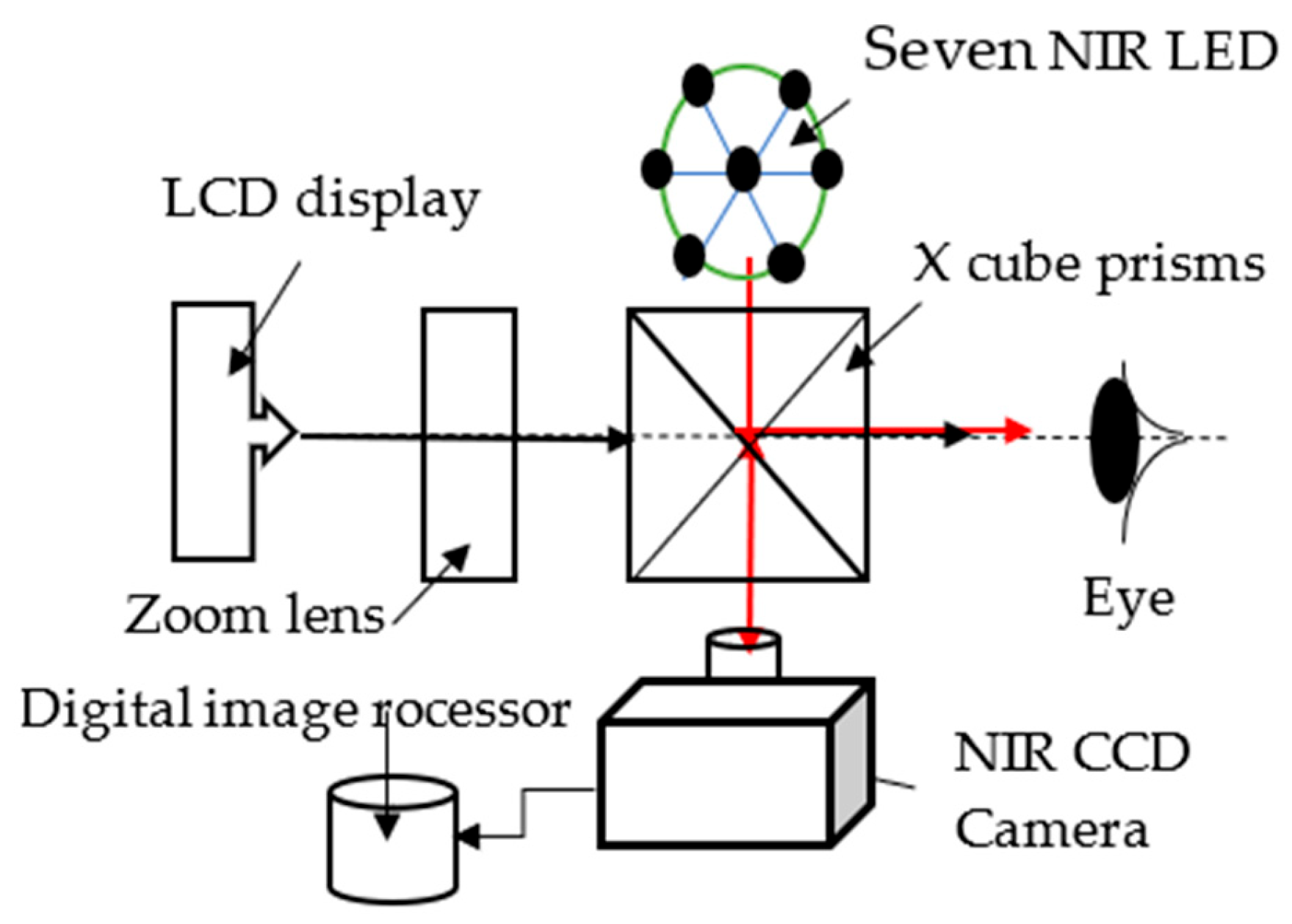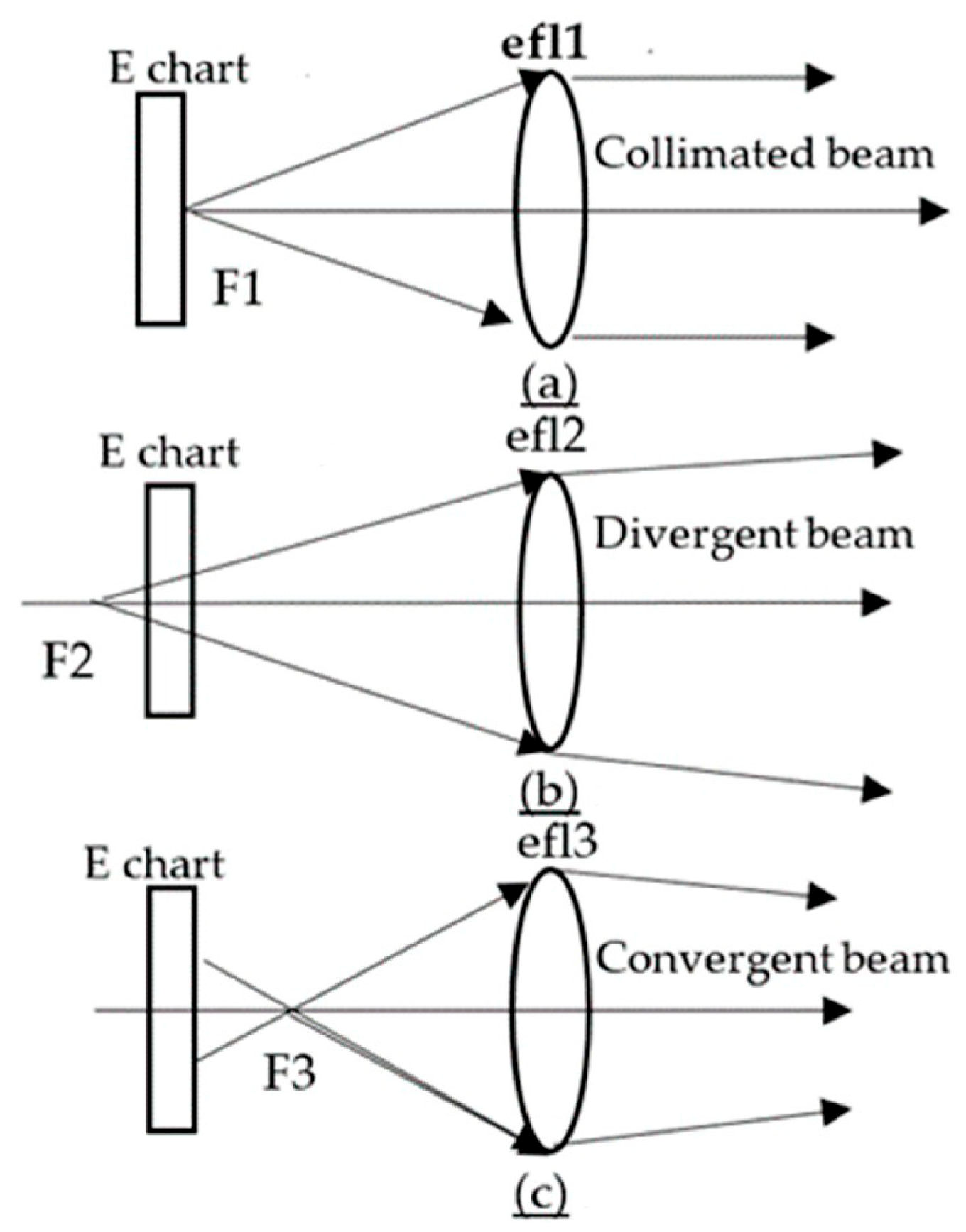Portable Vision Testing and Optometry Technology †
Abstract
1. Introduction
2. Principle
3. Experiment Results
- (1)
- Look directly at the house on the LCD in front of you to make sure that your line of sight is consistent with the system’s optical axis.
- (2)
- Replace the house pattern with a honeycomb pattern. Look directly at the honeycomb pattern to relax your eyes.
- (3)
- Observe the distance E chart for each eye separately to test the VA value of each eye.
- (4)
- Play the E letters of the E chart displayed on the LCD from large to small. Stop playing when the subject cannot clearly see a smaller letter E.
- (5)
- When the subject can clearly see the letter E in front of the small letter E, record the VA value at this time, and the VA test of this eye is completed.
- (6)
- Change the focal length of the zoom lens. If the small "E" in the previous step can be clearly seen at the longest focal length, then this eye is hyperopia.
- (7)
- If the small E in the previous step can be clearly seen at a short focal length, then that eye is myopia.
- (8)
- The preliminary eye examination results obtained in steps (6) and (7) are used as the reference value for the focal length in step (6) or (7). With further fine-tuning, the letter E will change from blurry to clear or clear to blurry. The best focal length value is when the letter E is the clearest.
4. Conclusions
Author Contributions
Funding
Institutional Review Board Statement
Informed Consent Statement
Data Availability Statement
Conflicts of Interest
References
- Blahnik, V.; Schindelbeck, O. Smartphone imaging technology and its applications. Adv. Opt. Technol. 2021, 10, 145–232. [Google Scholar] [CrossRef]
- Kreitzer, M.; Moskovich, J. Optical design of a smartphone zoom lens. In Proceedings of the SPIE 11106, Zoom Lenses VI, San Diego, CA, USA, 9 September 2019; p. 111060D. [Google Scholar] [CrossRef]
- Sun, W.-S.; Tien, C.-L.; Pan, J.-W.; Chao, Y.-H.; Chu, P.-Y. Optimization design of periscope type 3× zoom lens design for a five-megapixel cellphone camera. In Proceedings of the Second International Seminar on Photonics, Optics and Its Applications, Bali, Indonesia, 24–25 August 2016; p. 1015005. [Google Scholar]
- Hou, C.; Ren, Y.; Tan, Y.; Xin, Q.; Zang, Y. Compact optical zoom camera module based on Alvarez elements. Opt. Eng. 2020, 59, 025104. [Google Scholar] [CrossRef]
- Yang, T.; Jin, G.; Zhu, J. Automated design of freeform imaging systems. Light Sci. Appl. 2017, 6, e17081. [Google Scholar] [CrossRef] [PubMed]
- Fan, C.; Yang, B.; Liu, Y.; Gu, P.; Zong, H. Zoom lens with high zoom ratio design based on Gaussian bracket and particle swarm optimization. Appl. Opt. 2021, 60, 3217–3223. [Google Scholar] [CrossRef] [PubMed]
- Neil, I.A. Evolution of zoom lens optical design technology and manufacture. Opt. Eng. 2021, 60, 051211. [Google Scholar] [CrossRef]
- Lippman, D.H.; Teverovsky, D.S.; Bentley, J.L. Monte Carlo first-order design method for anamorphic cinema zoom lenses. Opt. Eng. 2021, 60, 051203. [Google Scholar] [CrossRef]
- Smith, W.J. Modern Optical Engineering, 5th ed.; McGraw-Hill Companies, Inc.: New York, NY, USA, 2008. [Google Scholar]
- Hecht, E.; Zajac, A. Optics, 5th ed.; Reading, Addison Wesley Publishing Company: Reading, MA, USA, 2017. [Google Scholar]
- Pedrotti, F.L.; Pedrotti, L.M.; Pedrotti, L.S. Introduction to Optics, 3rd ed.; Cambridge University Press: New York, NY, USA, 2018. [Google Scholar]
- Côté, G.; Lalonde, J.; Thibault, S. Deep learning-enabled framework for automatic lens design starting point generation. Opt. Express 2021, 29, 3841–3854. [Google Scholar] [CrossRef] [PubMed]
- Duerr, F.; Thienpont, H. Freeform imaging systems: Fermat’s principle unlocks “first time right” design. Light: Sci. Appl. 2021, 10, 95. [Google Scholar] [CrossRef] [PubMed]
- Hered, R.W.; Murphy, S.; Clancy, M. Comparison of the HOTV and Lea Symbols charts for preschool vision screening. J. Pediatr. Opht. Strab. 1997, 34, 24. [Google Scholar] [CrossRef] [PubMed]
- Reich, L.N.; Ekabutr, M. The Effects of Optical Defocus on the Legibility of the Tumbling-E and Landolt-C. Optom Vis Sci. 2002, 79, 389. [Google Scholar] [CrossRef] [PubMed]
- Smart home technology creates Independence for patients with disabilities. Available online: https://www.optometrytimes.com/view/smart-home-technology-creates-independence-patients-disabilities (accessed on 30 October 2023).
- Jiang, Y.; Zhu, Z.; Tan, X.; Kong, X.; Zhong, H.; Zhang, J.; Xiong, R.; Yuan, Y.; Zeng, J.; Morgan, I.G.; et al. Effect of repeated low-level red-light therapy for myopia control in children: A multicenter randomized controlled trial. Ophthalmology 2022, 129, 509–519. [Google Scholar] [CrossRef] [PubMed]
- Suo, L.; Ke, X.; Zhang, D.; Qin, X.; Chen, X.; Hong, Y.; Dai, W.; Wu, D.; Zhang, C.; Zhang, D. Use of Mobile Apps for Visual Acuity Assessment: Systematic Review and Meta-analysis. JMIR mHealth uHealth. 2022, 10, e26275. [Google Scholar] [CrossRef] [PubMed]
- Abdul Rahman, S.N.A.; Naing, N.N.; Othman, A.M.; Mohamad, Z.; Ibrahim, T.M.M.; Hashim, S.E.; Baig, A.A.; Wong, L.S.; Dewadas, H.D.; Selvaraj, S. Validity and Reliability of Vis-Screen Application: A Smartphone-Based Distance Vision Testing for Visual Impairment and Blindness Vision Screening. Medicina 2023, 59, 912. [Google Scholar] [CrossRef] [PubMed]
- Hanyuda, A.; Kubota, M.; Kubota, S.; Masui, S.; Yuki, K.; Tsubota, K.; Negishi, K. Validation of a novel iPhone application for evaluating near functional visual acuity. Sci Rep. 2022, 12, 22342. [Google Scholar] [CrossRef] [PubMed]
- Raffa, L.H.; Balbaid, N.T.; Ageel, M.M. Smart Optometry” phone-based application as a visual acuity testing tool among pediatric population. Saudi Med J. 2022, 43, 946–953. [Google Scholar] [CrossRef] [PubMed]





| −0.8 | −0.8 | −0.8 | −0.8 | −0.8 | −0.8 | −0.8 |
| −0.7 | −0.8 | −0.8 | −08 | −0.8 | −0.8 | −0.7 |
| −0.8 | −0.8 | −0.8 | −0.8 | −0.8 | −0.8 | −0.8 |
| −0.8 | −0.8 | −0.8 | −0.8 | −0.8 | −0.8 | −0.8 |
| −0.8 | −0.8 |
| 0.21 | 0.21 | 0.21 | 0.21 | 0.21 | 0.21 | 0.21 |
| 0.22 | 0.21 | 0.21 | 0.21 | 0.21 | 0.21 | 0.20 |
| 0.21 | 0.21 | 0.21 | 0.22 | 0.21 | 0.21 |
Disclaimer/Publisher’s Note: The statements, opinions and data contained in all publications are solely those of the individual author(s) and contributor(s) and not of MDPI and/or the editor(s). MDPI and/or the editor(s) disclaim responsibility for any injury to people or property resulting from any ideas, methods, instructions or products referred to in the content. |
© 2025 by the authors. Licensee MDPI, Basel, Switzerland. This article is an open access article distributed under the terms and conditions of the Creative Commons Attribution (CC BY) license (https://creativecommons.org/licenses/by/4.0/).
Share and Cite
Yeh, F.-M.; Chen, W.-H.; Hsieh, Y.-H.; Yeh, C.-H.; Chen, K.-M.; Chen, D.-C. Portable Vision Testing and Optometry Technology. Eng. Proc. 2025, 103, 28. https://doi.org/10.3390/engproc2025103028
Yeh F-M, Chen W-H, Hsieh Y-H, Yeh C-H, Chen K-M, Chen D-C. Portable Vision Testing and Optometry Technology. Engineering Proceedings. 2025; 103(1):28. https://doi.org/10.3390/engproc2025103028
Chicago/Turabian StyleYeh, Feng-Ming, Wei-Hsin Chen, Ya-Hui Hsieh, Ching-Hui Yeh, Kuang-Min Chen, and Der-Chin Chen. 2025. "Portable Vision Testing and Optometry Technology" Engineering Proceedings 103, no. 1: 28. https://doi.org/10.3390/engproc2025103028
APA StyleYeh, F.-M., Chen, W.-H., Hsieh, Y.-H., Yeh, C.-H., Chen, K.-M., & Chen, D.-C. (2025). Portable Vision Testing and Optometry Technology. Engineering Proceedings, 103(1), 28. https://doi.org/10.3390/engproc2025103028






